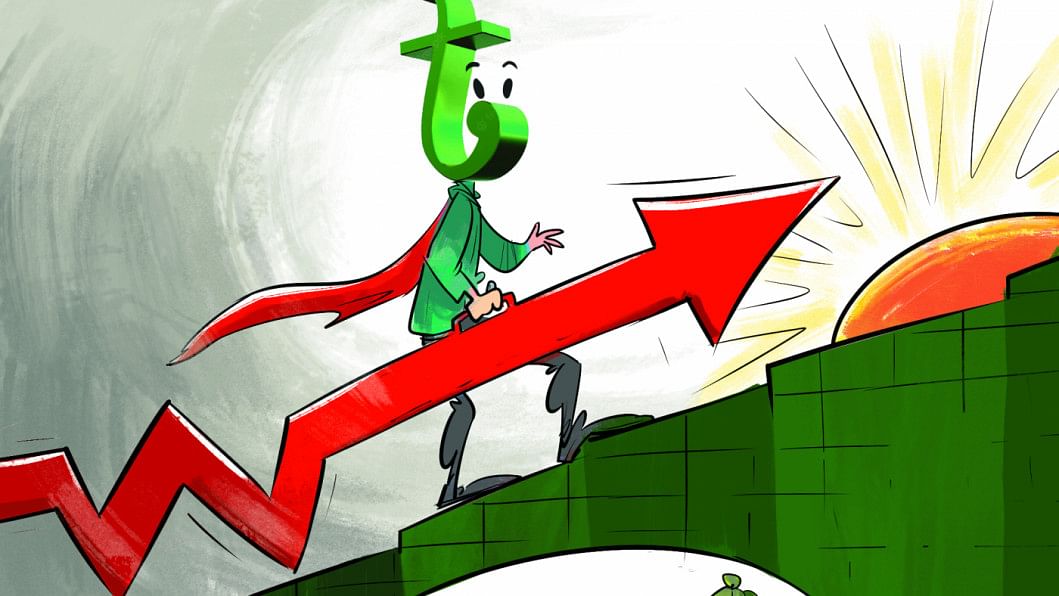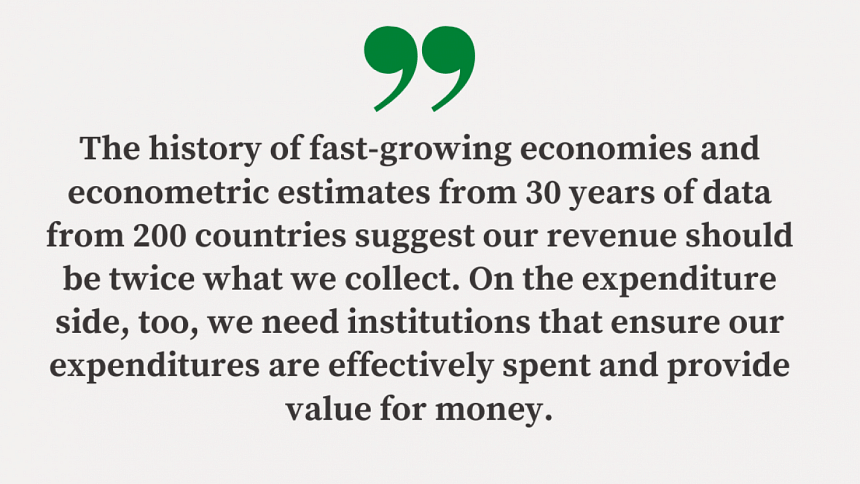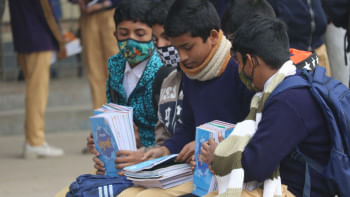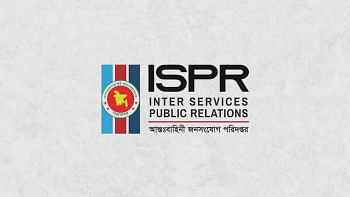Charting the middle-income journey

Sound macroeconomic management is like oxygen: unappreciated and unnoticed when it is present but causing immense suffering when it is not. When prices, interest and exchange rates go haywire, confidence flies away and uncertainty settles in its place – economic activities can sometimes ground to a halt.
Bangladesh's strong record of macroeconomic management that underlies our human development and poverty reduction is similarly unappreciated. For most of our history, we had moderate-sized deficits; we allocated our albeit insufficient public expenditures well to high-priority social sectors, rural development, road networks, and safety nets. In recent years, we have done a remarkable job of increasing public investment expenditures, especially in power, communications, and transport infrastructure. Furthermore, except for the last few years, our monetary policy has kept inflation and interest rates at reasonable levels, keeping our exchange rates competitive. That is not to say we haven't had longer-term structural problems, like meagre revenues constraining much-needed public expenditures and our development. Even so, in a narrow but essential sense, Bangladesh's macro management has been laudable.
However, having embarked on our middle-income development journey, we need to "raise our game," i.e. we need to increase our macroeconomic management skills by deploying technical expertise and research. We need to build institutions that not only use expertise, but also encourage critical discussions. Otherwise, there will be mistakes.
We have to raise our game because our economy is now facing challenges from three directions. First, we are facing strong headwinds from a fraught international economic environment caused by the Russia-Ukraine war that has drastically increased energy and food prices. That, along with long pending internal structural problems, has sharply raised the current account deficit, narrowed fiscal space due to rising interest payments and subsidy costs, and put pressure on the exchange rate and thereby on inflation and interest rates.
Second, we have the task of graduating from the LDC to the developing country status, defined by the United Nations, by 2026. When we do so, we will lose privileges such as duty-free, quota-free entry to Europe under the Everything-But-Arms programme and to markets such as Japan and Australia. Concessional lending will also be curtailed. Since these developments will increase costs significantly, we must raise our productivity markedly to be competitive.
Third, we are facing the first signs of what some economists term the "middle-income trap." That term refers to the slowdown of productivity growth of middle-income countries when they approach higher income per capita levels. In research, high-income economies are defined by their per-capita income relative to the United States. That bar is high. More straightforward and inclusive is the World Bank's definition of high-income countries measured in per capita income to be between USD 12,000 and USD 12,700 in current prices for the past 10 years. As an economist, I would have preferred these measurements to be in PPP dollars rather than nominal dollars. But likely due to data and official constraints, the discussion is in US dollars.
In either case, the results are similarly forbidding. In the past 33 years where the World Bank has data and classification benchmarks, only 21 countries have managed to cross from middle-income to high-income. However, most of these countries were either island states that prospered in the tourism booms of recent years or city states, and European economies, such as Portugal, most of them members of the European Union. During this period, only four countries that did not belong to these groups – Chile, Uruguay, Oman and South Korea – managed to become high-income.

On the other hand, we had mature economies such as Argentina, Brazil, Mexico, Malaysia and Turkey hovering close to the higher income threshold for many years, but unable to cross it. Sometimes, Argentina and one or two other countries have crossed the threshold to become high-income, only to slip back into middle-income status.
An intriguing case is China, which grew spectacularly for three decades, averaging at 10 percent per annum. However, as the middle-income trap would predict, its productivity growth has sharply slowed by more than half over the past decade. That has dragged down growth rates to less than seven percent in the ensuing years; the estimate for 2022 growth is a crawling three percent. China's economy is now burdened with excessive dependence on debt, a slowing construction sector, overbuilt infrastructure investment, a suppressed and shaken private sector, a sharp slowdown in exports, and a flawed approach to managing Covid-19. National pride and political considerations have led China to reject the mRNA vaccines and follow a rigid zero Covid policy of lockdowns, severely damaging the economy.
Why does growth slow down in middle-income countries? Because sustaining economic growth at that higher stage requires robust institutions, knowledge, innovation, and research. Institutions need to secure human and property rights, not only from the state but also from powerful oligarchies. Preventing excessive economic inequality and elite capture of the state, which often go hand in hand, is also needed. It is worth noting that Chile, one of the three breakthrough countries that graduated into the high-income category, did so in 2012, well after the overthrow of military dictator Pinochet and restoration of electoral democracy.
So, what does this have to do with Bangladesh, where per capita income is over USD 2,800 (according to the Bangladesh Bureau of Statistics)? It is relevant because indicators suggest that there may be middle-income traps not only at higher middle-income levels, but also at lower per capita income levels. A look at the evidence for some of the countries discussed above also shows a pause in growth at different points, when their per capita incomes were between USD 3,000 and USD 5,000. Much of that took place in the 1990s when these countries were dealing with high debts, exchange rate volatility, fragile but overstretched financial sectors, the Asian financial crisis and internal structural problems, including the dominance of oligarchies and crony capitalists.
Bangladesh is now approaching a similar range of per capita incomes, also in a similar period of turbulence and with some similar features. The challenges to macroeconomic management of a large-sized economy have grown more complex. These challenges are both short- and long-term. The long-term challenges are no less urgent. How we deal with education quality, urban and infrastructure development, and environmental and climate change challenges now will soon determine our growth trajectory. For instance, three national student assessments have shown that learning sharply deteriorates between classes 3 and 5. In Class 5, more than 80 percent of students did not show grade-level competency in either Bangla or in mathematics. My ongoing research on urban development suggests there is trouble: cities and towns are struggling to provide the jobs, the investment climate, and the public services needed to support growth.
The short-term challenges need urgent attention. Let us take three. First is the need to increase revenue collection, where Bangladesh falls short. The history of fast-growing economies and econometric estimates from 30 years of data from 200 countries suggest our revenue should be twice what we collect. On the expenditure side, too, we need institutions that ensure our expenditures are effectively spent and provide value for money. Currently, the budgets and the authority for monitoring, evaluation, and holding public agencies accountable, vested in the Implementation Monitoring and Evaluation Division (IMED) under the planning ministry or the Public Accounts Committee of the parliament, are unclear and grossly inadequate. Similarly, the resources, arrangements, and organisations for collecting and sharing goods and time data, an essential requirement for managing a middle-income economy, are also highly inadequate.
Addressing these needs will require not only the right policies, but also – more importantly – more robust institutions. There is no reason to think we can overcome the middle-income challenges – faced by economies in all continents – without addressing these needs.
Dr Ahmad Ahsan is the director of the Policy Research Institute (PRI) of Bangladesh and a former World Bank economist and Dhaka University faculty member. Views expressed in this article are the author's own.

 For all latest news, follow The Daily Star's Google News channel.
For all latest news, follow The Daily Star's Google News channel. 






Comments